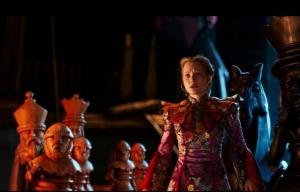'Looking Glass' built on swamp of original 'Wonderland'
The summer’s first belly flop has been witnessed and it’s nowhere near a pool. “Alice Through the Looking Glass” has slapped its pasty-white tummy against the still box office waters, and every prognosticator is pointing fingers at who is to blame.
Could it be the lack of Tim Burton at the helm this go-round? Is it the public pall cast over lead Johnny Depp’s personal life at the moment? Is it the crush of superheroics currently dominating theaters?
Or, quite possibly, is it that the film that launched it (“Alice in Wonderland”) was not strong enough to support a sequel in the first place? Burton at least had the advantage of being first out of the gate, and from an artistic perspective he did not disappoint. Sumptuous visuals, well-appointed costume design, a cast and crew of Burton stalwarts (Helena Bonham Carter, Johnny Depp and Danny Elfman as composer) all wrapped the film in a gauze of importance, but for what, exactly?
Hollow at its core, “Wonderland” was an example of extravagant window dressing for an empty store. When stripped of all its lovely appointments, there seemed to be a fundamental lack of understanding of the source material that retrofitted Lewis Carroll’s classic into a Hero’s Journey narrative that undercut the wondrous wit and wordplay of the novel.
So when newcomer James Dobbin began construction of the sequel, it was built on a swamp of a story, and he can hardly be faulted, as he follows Burton’s lead for much of this follow-up. Alice (played by Mia Wasikowska) returns from abroad to find her home estate in shambles, but before she can tend to any matters, she is summoned again down the rabbit hole to help her ailing friend, the Hatter (played by Depp), and reconnect him with his family.
And instead of spending time with the original animated underworld cast, they are pushed aside to introduce Time (played by Sacha Baron Cohen), extrapolate on the family squabbles between the Red Queen (played by Carter) and White Queen (played by Anne Hathaway), and unfurl a time-traveling subplot that seems to exist solely to exhaust the remainder of the film’s budget.
And while Cohen seems at home with the weirdness, Hathaway and Carter pick up right where they left off. The entire affair feels wobbly and ready to tumble as it once again adheres to the original's linear narrative. And it plays too safe with an author who seldom did. Carroll would often play with language like a kitten with yarn, which led him to unspool such works as “Jabberwocky,” and the “Alice” books were equally as unconventional.
The result is just another castle quest, like the ones seen time and again in such films, perhaps with only a slightly more colorful palette. Buried deep within there are some strong messages for young female filmgoers about self-empowerment, but they are suffocated in a blanket of special effects that dulls any edge it could have carried.
The result is merely a video game in movie’s clothing, using familiar, beloved characters to help sell it. And for a story that praises its lead for breaking the mold, when the film so closely adheres to it, the results can indeed be maddening.





















































